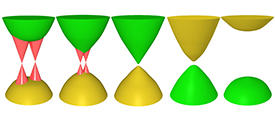

10/28/2013

Reproduced from Ref. 1 © 2013 American Physical Society
Symmetry is an important concept that must be taken into account to explain the properties of the Universe, as well as those of molecules and atomic crystals. Researchers from the AIMR at Tohoku University, together with collaborators from Osaka University, have now shown how the symmetry of crystals of tin telluride (SnTe) can be modified such that the material demonstrates various electronic effects1,2.
Tin telluride is a conventional semiconductor with commercial applications in infrared photodetectors. A feature of the compound is that its crystals are mirror-symmetric, meaning that they do not change upon reflection. As a consequence, the electronic states at the surface of the crystal are protected against perturbations. Such crystals are classed as topological crystalline insulators and exhibit ‘topological states’ on their surface.
A practical advantage of these topological states, explains Seigo Souma, a member of the research team, is that the material’s electrical conductivity is independent of size. “Normally, when we reduce the size of the conducting material, at some point electrons cannot move and the material becomes insulating. This is a real limitation when down-sizing electronic devices. However, materials with topological protection could overcome such limitations.”
In tin telluride, topological states can be controlled by changing the atomic composition of the crystal. Souma and his colleagues replaced some of the tin with lead, discovering that when the lead content was 75% or higher, the topological states disappeared1 (see image).
As well as destroying these states, the researchers also found that they could alter them. When they replaced a low percentage of the tin with indium instead of lead, the samples became superconducting at low temperatures. Owing to the symmetries of the modified crystal, the resulting material, Sn1-xInxTe, is a rare form of a topological superconductor2. Interestingly, topological superconductors are predicted to contain an unusual class of particle known as a Majorana fermion. As their own anti-particle, these fermions possess some unique properties and are very stable to external perturbations, making them appealing for use in electronic applications.
Souma notes that with the ability to control symmetries and topological states through atomic substitution, new possibilities arise — including further investigation into the existence of the Majorana fermion. “One interesting future possibility is to create thin layers of tin telluride/lead telluride in a device. As topological states do not only exist at the surface, but can also arise at the interface between a topological and an ordinal material, one can encapsulate the topological state between these two layers.”
Tanaka, Y., Sato, T., Nakayama, K., Souma, S., Takahashi, T., Ren, Z., Novak, M., Segawa, K. & Ando, Y. Tunability of the k-space location of the Dirac cones in the topological crystalline insulator Pb1-xSnxTe. Physical Review B 87, 155105 (2013). | article
Sato, T., Tanaka, Y., Nakayama, K., Souma, S., Takahashi, T., Sasaki, S., Ren, Z., Taskin, A. A., Segawa, K. & Ando, Y. Fermiology of the strongly spin-orbit coupled superconductor Sn1-xInxTe: Implications for topological superconductivity. Physical Review Letters 110, 206804 (2013). | article
This research highlight has been approved by the authors of the original article and all information and data contained within has been provided by said authors.